When setting up a goldfish tank for the first time, it’s important to choose a suitable substrate for the base. But what is the best substrate for goldfish?
The answer is that there isn’t just one good substrate for goldfish or a single choice of the ‘best’ substrate in all situations.
Your choice of substrate will be influenced by a number of factors, which are specific to your tank. These include the type of goldfish you are keeping, whether you will be keeping live plants, whether you’re happy for those plants to be in pots, and your personal preference for how the tank will look.
So, how do you choose the best substrate for YOUR goldfish? Read on to find out.
Do goldfish need substrate?
Before we try to decide on the best substrate for your goldfish tank, we should first stop to think about whether goldfish need a substrate at all.
And the answer is that goldfish don’t need substrate. There’s nothing essential about having a substrate and goldfish can survive quite healthily and happily without one.
So, as goldfish don’t require a substrate, you could choose to simply leave the bottom of your goldfish tank bare. The best substrate for your goldfish might actually be no substrate at all!
Before moving on to other substrate options, let’s look at the pros and cons of a bare bottomed tank.
Benefits of a bare goldfish tank base
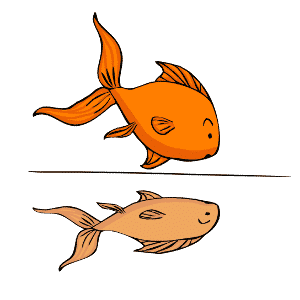
One of the most obvious benefits of leaving the bottom of the tank free from any substrate is that cleaning the floor of the tank becomes really simple, as you do not have to sift through gravel or sand to clear the waste left behind by your goldfish.
Also, as there is no gravel or other solid substrate present to collect waste products, there is less possibility of the water taking on the off-color or yellow tinge that often accompanies the lifecycle of decaying organic matter.
Goldfish are famous for rooting around in the substrate and sucking up sand or gravel, which can potentially lead to problems such as injuries and choking. Of course, these problems don’t occur if there is no substrate to get at.
A bare bottomed tank can also be one of the best substrate choices when you need to provide a little more room or water volume within your tank. Substrates take up space that can otherwise be used for more water.
Potential problems with a bare base
The first potential problem with a bare bottomed tank is its appearance. It is not appealing to everyone and some fish keepers feel that it makes the tank look unfinished.
Secondly, goldfish generate a lot of waste, which will be very easily visible on the bare floor of your tank. This is great for easy cleaning, but not good for maintaining a tidy appearance.
The growth of algae within the tank and any green algae breakouts will also be much more noticeable against the bare glass base of the tank.
A bare base may not be the best substrate choice if you wish to grow plants within your tank.
Plants in bare base tanks need to be grown in pots, as there is no substrate present for them to put down roots.
Finally, by choosing a bare bottomed tank, you will also be restricting some of the natural behaviors of your goldfish. Goldfish like to dig about in substrate and it can be entertaining to watch your fish enjoying this.
If you don’t want to keep your goldfish tank bare then gravel, sand or pebbles may be the best substrate option for you. Let’s look at the pros and cons of each in turn.
Gravel for goldfish tanks
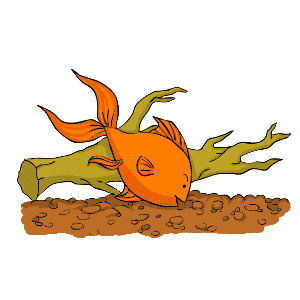
Whether gravel is the best substrate for goldfish is debatable, but it’s certainly the most popular substrate.
Almost all beginners start out keeping goldfish in a tank with a gravel substrate.
Here’s what you need to know…
What type of gravel should you use?
When you buy gravel to add to your fish tank, you should also make sure that you use a type of gravel that is designed for fish tanks, not just any old gravel you might find in a garden for instance.
Fish tank gravel is distinct from regular gravel in that it is specially designed for use within fish tanks.
It is different to the type of gravel used in construction as it will not leech toxins or dust into the water, and is smooth-edged to avoid injuring the fish.
Aquarium gravel is available in a wide variety of sizes from coarse to very small grains, and in a wide variety of colors to suit every taste.
How to add gravel to the goldfish tank
Before you go about adding gravel to your goldfish tank, it is important to ensure that the gravel is clean.
Rinse the gravel several times in clean, fresh water without adding any chemicals or soaps, and ensure that no dust or debris are still being rinsed off the gravel when you add it to the tank.
Your goldfish tank should already be at least a third full of water before you pour in the gravel, as otherwise, adding gravel to an empty tank and then pouring in water will stir up and disturb your aquascaping!
If you are putting any ornaments or decorations into your tank, place these in the water before you add the gravel, so that they will be given a firm base on the floor of the tank with the gravel surrounding and supporting them.
When you have poured the gravel into the tank, arrange it with your hands so that it is higher at the back of the tank than the front. This will not only add depth and perspective to the appearance of the tank, but will cause any waste and debris to roll towards the front of the tank for easier removal.
Is gravel the best substrate for goldfish?
Gravel is one of the most popular tank substrates used for goldfish, but if the gravel pieces are small enough then there is a risk that your goldfish may swallow it or even choke.
Small pieces of gravel are generally not a good pick for the goldfish tank, due to the risk of your goldfish swallowing it or getting it stuck in their throats.
You can avoid this issue by using gravel that is larger than pea size, as your goldfish are highly unlikely to be able to suck them into their mouths.
Gravel has to be up there as one of the best substrate options for goldfish tanks, as it provides good filtration of the base of the tank, offers a good base for planting aquarium plants, and is visually attractive to the goldfish tank viewer.
How to clean a gravel substrate
When you clean out your goldfish tank, you will need to use a siphon with a filter to agitate the gravel and suck up any waste particles without picking up the gravel as well.
As long as you do this regularly, your gravel should not become too discolored or begin to collect algae.
We advise against cleaning your gravel, as it can disrupt the balance of bacteria in your tank and lead to ammonia spikes. Instead, simply vacuum the gravel with your siphon and accept any patches of algae on the gravel as the natural appearance of a healthy fish tank.
Sand substrate for goldfish
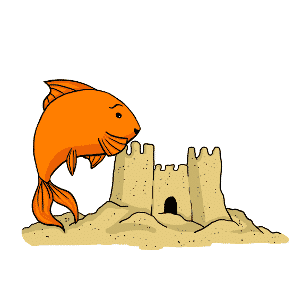
Sand is another great option for the base of your fish tank.
As with gravel, you should make sure that you buy aquarium sand, rather than just any type of sand.
Aquarium sand is specially produced for use in fish tanks. It is a high quality soft sand that is filtered and sieved to remove any debris. It is often artificially colored to give fish keepers a choice of shades to match or contrast with the rest of the aquarium décor.
If you are considering using sand as the base for your goldfish tank, it is important to ensure that you buy sand that is specially designed for use with freshwater fish.
Marine fish require a sand substrate that is known as “live sand” and contains salt, bacteria and microorganisms that are designed to work well with a saltwater fish tank, but that will be unsuitable for a freshwater set up.
Goldfish tank sand is often available in a wide range of different colors, and you can mix and match them to create new designs, such as by layering different colors of sand or mixing colors to create a unique design all of your own.
How to add sand to the goldfish tank
To add sand to your goldfish tank, begin by adding water to your tank, to around a third or half full.
Then, place your ornaments within the tank before adding the sand.
Rinse out the sand you are going to use thoroughly to remove any dust until the water runs clear before adding it to the tank.
Then, slowly pour the sand into the tank, using it to support the base of any ornaments present and ensuring a good, even coverage to a depth of an inch or two.
You may wish to slope the sand from the back of the tank to the front, so that debris and waste will fall towards the front of the tank for easier cleaning.
When you first add sand to your tank, it may cloud the water and take some time to settle; this is normal, so give it some time to settle down.
Is sand a good substrate for goldfish?
Fish keepers as a whole are rather divided in opinion as to whether or not sand makes a good substrate for goldfish or not.
One school of thought is that sand is not the best substrate for goldfish as it can irritate the gills of goldfish. However, this is not a major problem in most cases and many goldfish live quite happily and healthily in tanks with sand substrates.
How to clean a sand substrate
Unlike gravel, waste products do not generally fall through sand and become suspended between the grains, but will generally sit on the surface of the sand. This can make it easier to clean than gravel, as you will not need to sit through it to remove waste products.
However, using a siphon with sand can be a challenge, as the siphon will suck up the sand along with the water!
You will need to filter out the surface of your sand with a siphon and then skim it for solid particles, before returning the cleaned sand to the tank.
Large stones and pebbles
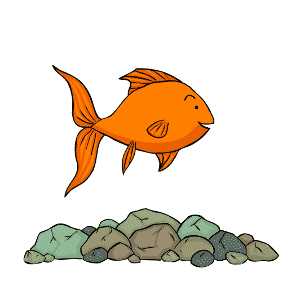
Large stones ands pebbles are one of our favorite types of substrate. Pebbles have the advantages of gravel – such as allowing the fish to forage in the gaps between stones – but without the risk of choking or being injured on small sharp pieces. They also look really striking.
Both pebbles and river rocks are significantly larger than goldfish tank gravel, but can vary in size considerably.
Pebbles can range in size from the size of a fingernail up to a couple of inches in diameter, while river rocks are larger again.
Pebbles can be made of glass, ceramic or rock, and are generally manually tumbled to produce a uniform size and shape, and are sometimes produced synthetically to introduce bright colors and designs.
River rocks and stones are taken from rivers and streams, where the natural flow of the water has smoothed and rounded the rocks over time.
River rocks are usually available in subtle, natural colors and are usually relatively large.
How to add pebbles or river rocks to the goldfish tank
To add pebbles or river rocks to your goldfish tank, first add the water.
Then, place any ornaments or decorations around the tank in the final positions where you would like them to be.
For smaller pebbles, you can then pour them into the tank directly as you would with gravel, and then use your hands to move them about and get them located where you would like them to be.
For larger pebbles and for river rocks, you will need to place them manually within the tank to avoid splashing about!
Ensure that your rocks or pebbles are rinsed and clean before you add them to the tank.
And obviously, be careful not to drop any large rocks, as you could crack or scratch your tank!
Are pebbles or river rocks the best substrate for goldfish?
Pebbles or river rocks can be one of the best substrate choices if you are worried that your fish are going to eat small pieces of sand or gravel, which can lead to health problems and irritation.
However, pebbles and river rocks are not usually the best substrate to use in a planted goldfish tank, as the plants will have nowhere to take root.
You can however get around this by keeping your plants in pots.
How to clean pebbles or river rocks
You can easily siphon waste products and debris out of the tank from your pebbles or rocks without unduly disturbing the display or sucking up the pebbles as well.
Over time, your substrate may begin to grow algae and slime, and if this becomes unsightly, you will need to remove the rocks or pebbles and scrub them with a toothbrush or scrubbing brush to remove it.
The Best Substrate for Fancy Goldfish
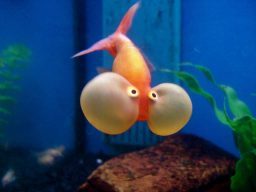
Certain types of fancy goldfish do have special requirements that make some substrates more suitable than others.
If you’re keeping fancy goldfish, it’s a good idea to think about their particular needs and make sure you choose the best substrate for them.
We often advice against using gravel in a fancy goldfish aquarium, as it is likely to contain sharp pieces that could damage the goldfish’s eyes or their wen.
If we had to choose a single best substrate for fancy goldfish tanks, we’d probably go for pebbles. This is because you can choose large round pebbles that have no sharp edges, which reduces the risk of injury to your goldfish’s eyes or to their wen.
Pebbles also look attractive and are easy for goldfish to see, even those fancy varieties with poor eyesight.



Is bottled water okay to use in tank? I have well water and it’s not drinkable for us. What do you recommend?
Hi Alison,
Bottled water is okay, just make sure it is “filtered” water and not “Distilled” water as it needs to contain some level of minerals within it.
Pure distilled water will kill fish.
You could also attach a hose pipe to your well and link a carbon dechlorinator to it, this will filter out most of the bad contents in the water, but be cautious as it may not be completely safe to use.
hope this helps.